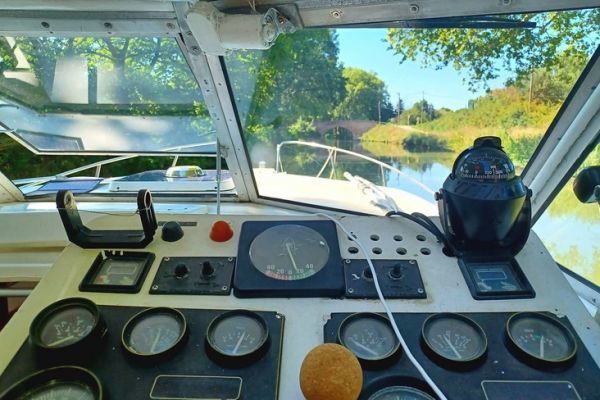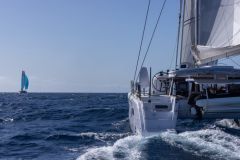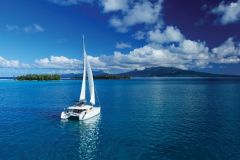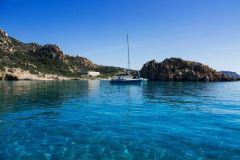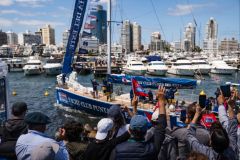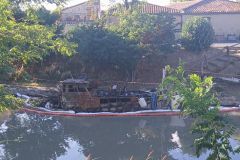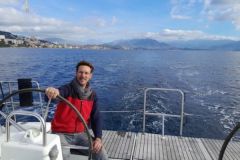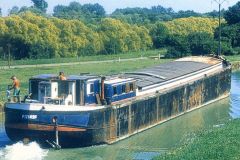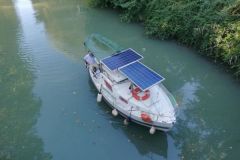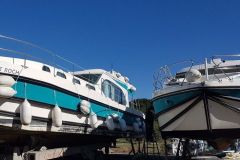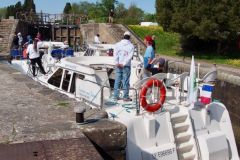Stéphane is a true novice. But with unshakeable faith, he embarked on his nautical adventure. Having only ordered his small boat and 6 hp on the canals, here he is buying a 9.15 m motorboat: a 1968 Fjord 30 Diplomat. A farmer at heart, he dreamed of traveling and sailing. He took the plunge and bought Farniente.
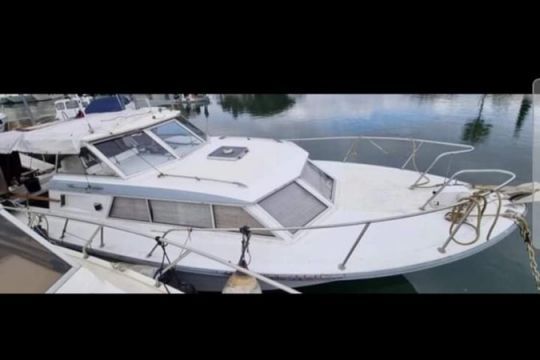
This great opportunity caught her eye in Cannes harbor. A bargain! He snapped it up for 3,000 euros and even negotiated to leave the boat in its place for 3 months at the port, just long enough to come and pick it up. Stéphane's plan is to bring his boat close to home, inland to Buzet-sur-Baïse, with a view to renovating it.
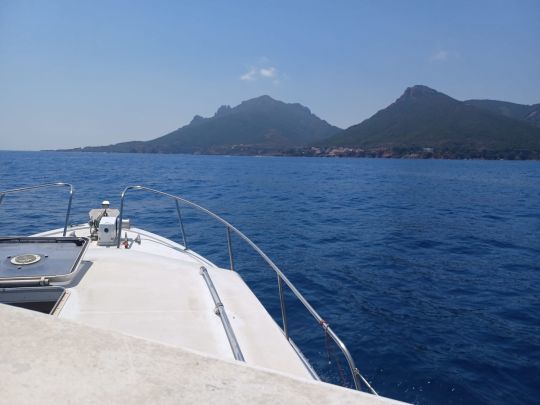
The weakness of this boat - hence its price - lies in its engines. These are 2 x 150 hp Volvo TAMD 31P Z-drives. To begin with, the base jacks no longer respond and the bases can no longer be raised. There are also a few signs of weakness in use. Nevertheless, both engines are running, which suggests the possibility of conveying.
From discovery to discovery
The two weekends leading up to the start of the convoy have revealed a number of weaknesses on the boat. The most important of these is the non-existent or rarely available reverse gear on an engine, which is very inconvenient when docking or simply maneuvering. What's more, the starboard engine spits out a little oil during rough maneuvers, and smokes black during strong acceleration. Importantly, this is where the hydraulic power steering is connected. It mustn't stop, otherwise it's the end of the trip. Not to mention the automatic bilge pump, which only works in manual mode...
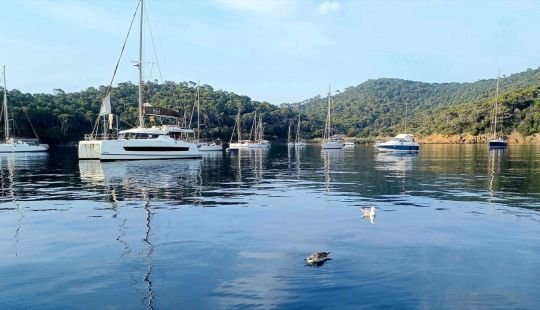
It's shaping up to be a wonderful trip, but it could also come to an abrupt end without even arriving in Marseille.
First day of delivery, first problems
On July 16, 2023, Stéphane sets sail. Before doing so, he empties the starboard engine that seems to be giving him trouble, just to reassure himself. From Cannes, he aims for Porquerolles, some 70 nautical miles to reach his first anchorage.
After 50 miles, the turbo on the port engine seems to have given up the ghost. The engine peaks at 2400 rpm. From 8 knots with the 2 engines, Farniente is now sailing at 7 with one engine at 2700 rpm and the other lowered to 1800 rpm. The adventure begins!
In the end, the first anchorage at Port Man on the island of Port-Cros is reached. At this time of year, Stéphane is not alone. He discovers the joys of anchoring. He says: " It's crowded, but I trust my free Orca app and drop my anchor in front of a sailboat in theoretically 5 m of water. Letting go of the chain, I burn my hands. No time to rest. The wind changes, and I'm up against a catamaran. I leap up to limit the impact, but fortunately the wind puts my boat back. A yachtsman anchored a little further on comes to see me. He advises me to give a little more chain for safety. Thanks to him. I'm a bit lost: my hands are grated and my head is out of shape from all the events and situations I've had to deal with today. So far removed from my everyday life! "
The joys of cruising
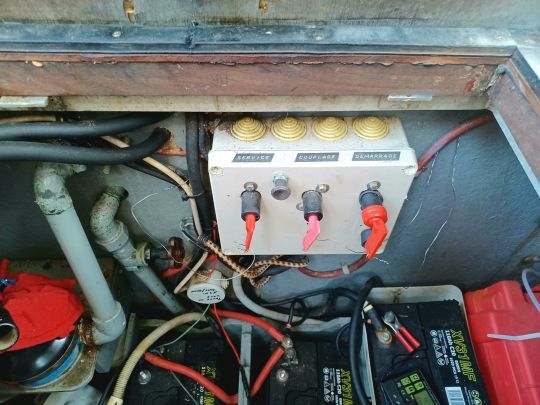
The next morning, Stéphane discovers that the fridge and mast fire have taken their toll on the service battery. Surprisingly, although both engine batteries are at over 13 volts, the engines refuse to start. The starter motors won't start. Incomprehensible! Clearly, the electrical circuit also needs to be overhauled. In doubt, he plugs in a small portable solar panel to try and recharge, and takes it easy in this beautiful anchorage on a windless day.
Faced with capricious weather
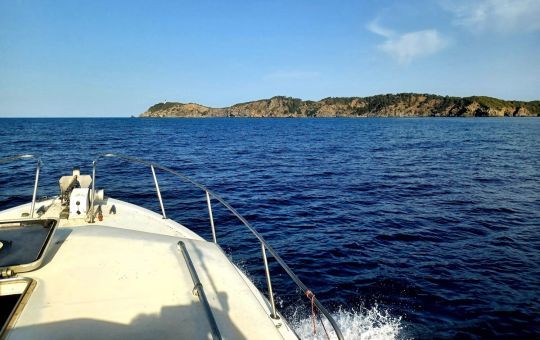
But it was not to be a quiet night. Stéphane was awakened by a wind strengthening to over 20 knots. The boat rolls a lot, but the anchor holds. This was not to be the case for everyone, and some sailboats were forced to rewet during the night. At around 5 a.m., the wind died down, and after 1 hour's sleep, Stéphane understood and repaired his electrical problem The wiring is poorly designed. Starters are connected to all batteries. "Early in the morning, he set sail again, taking advantage of the passage between the islands of the Sun : "beautiful islands, rocky coasts, aggressive, but so pretty. "
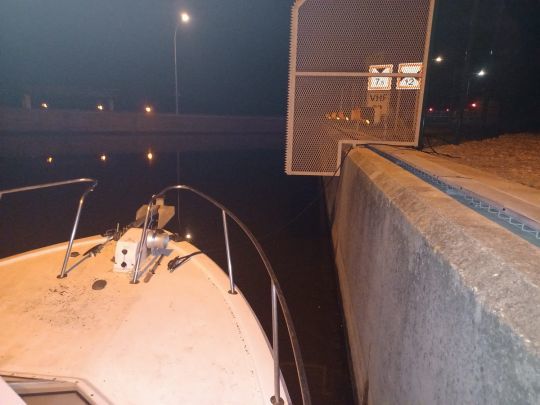
But the weather changed. In the afternoon, the wind picked up as they approached Marseille, and the sea became chaotic. Sheepsheads and a 1.50 m swell forced the helmsman to change course by 20 degrees on each tack. What's more, the forecast for the following day is not comforting. The wind and sea are expected to be worse. Not exactly reassuring for this sailing novice. So he decided to head up the Rhône, entering near Fos-sur-Mer. He ended up sailing at night, with a not-very-suitable mooring at the foot of a lock. The next day, he discovered that this navigation channel was forbidden to pleasure craft, and reserved for professionals!
The pleasure of river cruising
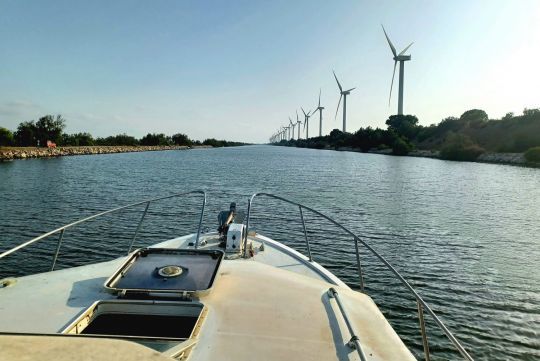
In the morning, the friendly lock-keepers let him pass his first lock. The journey up the Rhône continues as far as Arles, where he can fill up with diesel. Clearly, his new river navigation charts are not up to date. He misses the entrance to the Petit Rhône and sails 40 km further north. Once he's turned around and found the fork, Stéphane takes advantage of the situation: " Navigation on the Petit Rhône is magnificent. A small, wild river, but extremely well signposted so that boats with a draught of 2.50 m can sail serenely. "Now he's on the Canal du Rhône à Sète, where he improvises a fairground mooring for the night: in the middle of the Camargue, with horses on the banks.
Convoying in the Camargue
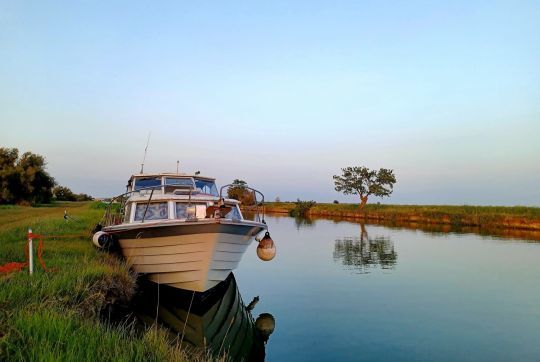
The Canal du Rhône à Sète crosses a number of ponds. Its maintenance is minimal, and its banks often disappear. We took a short break in Frontignan to wait for the bridge to rise, then crossed the Etang de Thau with the wind and waves as forecast. The bridge is regularly covered in spray, which sticks salt all over the boat.
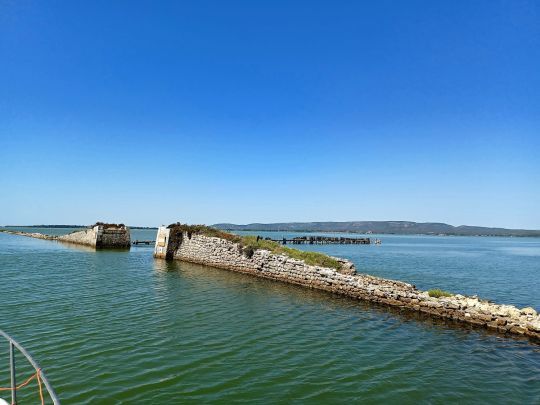
At the far end of the Etang de Thau lies the Canal du Midi. It seems tiny after the sea and the Rhône. Passing through the first lock is a bit of a folkloric maneuver, with the Farniente little maneuvering, no reverse, and alone on board!
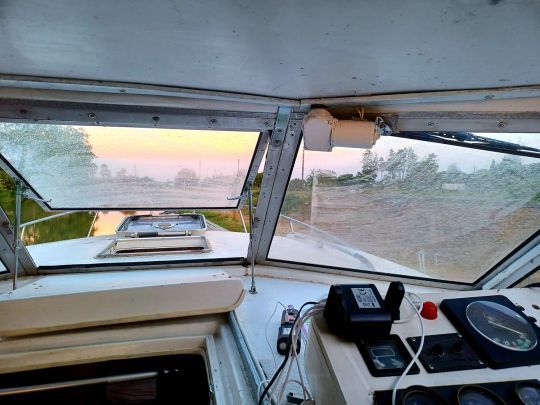
Navigation on the Canal du Midi
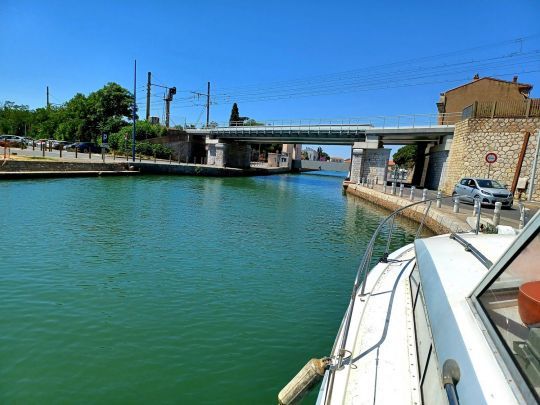
The Canal du Midi as far as Béziers is both abandoned and crowded with people on the banks and rental boats on the water. The Fonséranes passage, with its ladder of 7 locks, quickly gives you a sense of height. It's impressive, but in no way designed to accommodate 3 x 10m boats at the same time. The bollards are inadequate and, above all, poorly positioned. Stéphane is forced to put his Farniente across, with gear engaged, for the lock gates to close behind him.
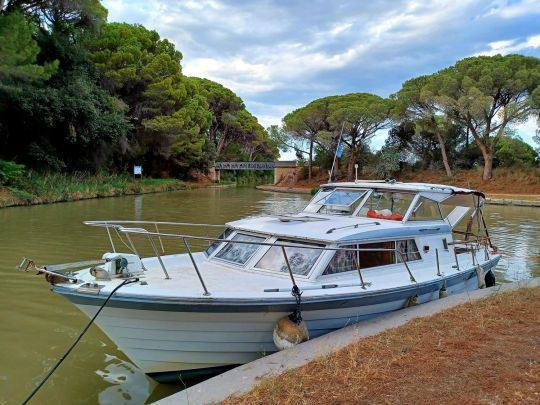
The reward comes after Béziers, where the canal is beautifully maintained. Of course, the speed limit is 8 km/h to limit bank erosion. And 8 km/h isn't much, especially when the wind is blowing hard and taking the boat with it. After Béziers, the starboard reverser - the one without reverse gear - was temperamental when it came to shifting into forward gear. The result: a scratch on the hull as we left a lock!
The pleasures of river cruising
Stéphane goes from lock to lock with their discoveries. For him, who sails solo: " some VNF seasonal workers do the minimum, i.e. just press the remote control. Others, on the contrary, are there to help you, and ensure safety. In fact, they have the upper hand over every captain who passes through the lock. Fortunately, many of them have been great! "
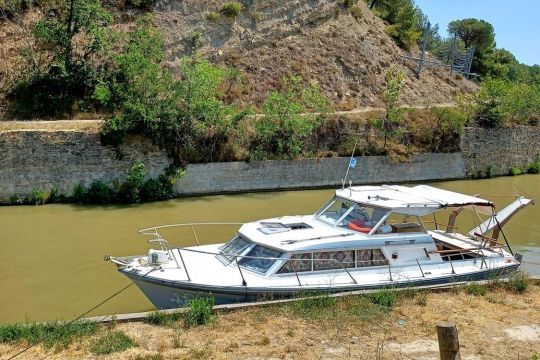
Mechanically, Stéphane is not at ease. One engine always consumes more than the other. But all the fuel stations listed in the official Canal du Midi guide only fill up... with water! The harbour master's offices don't even know where a boat can buy fuel.
In Homps, for example, the third port of call for refuelling, Stéphane can only find a petrol station for cars, 500 m from the canal. He would need 300 liters. Impossible with jerry cans! Fortunately, opposite the Farniente mooring, there's a Le Boat rental base. The manager, a friendly Belgian by birth, agreed to help him out with 100 liters. What's more, after discussing his personal boat, he offers him a can of ice-cold Coke and a VNF guide to the Canal du Midi, used and scribbled in places, but 10 times more accurate than the one on board. " There are still some passionate river charterers out there. That's great! "
As far as navigation is concerned, Stéphane has had a few scares A grandpa with a 4 m wide boat who wouldn't leave the center of the canal and called me crazy. Or a bridge entrance followed by a bend where a rental boat arrived without having slowed down. "He is discovering that inland navigation can be more demanding and stressful than sailing at sea.
Two is better than one!
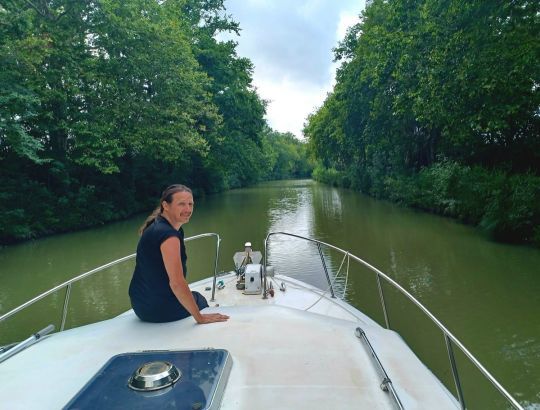
In Carcassonne, Stéphane picks up a friend to accompany him as far as the Toulouse exit. Going through the locks is easier with two people. Especially with a boat that only runs on one engine. The starboard reverser has obviously given up the ghost with a bang. But Stéphane still has to start this motor, as it's the one that powers the hydraulic steering.
The navigation continues with surprises, like the passage to Toulouse where the depth of the canal is less than 1.20 m, with the bases often rubbing. And there's always the worry of damage to the propeller of the one and only engine.
Bricolage and galley
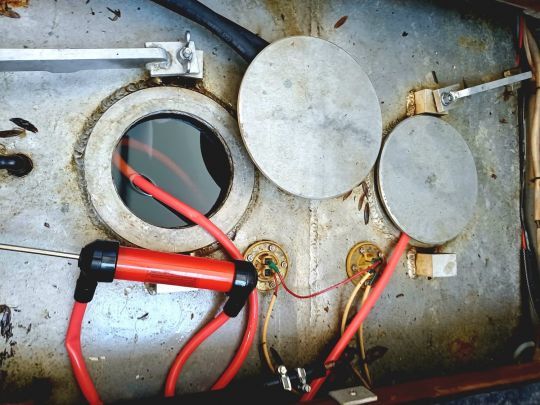
Wake-up call at 4:00 am on the morning of day 14. Stéphane had forgotten to turn off the fridge the night before, so the service battery reads 11.5 V. The starters refused to work again. The sailor had to modify the wiring and try to improve it to solve this recurring problem. Unfortunately, the same cable is used to power the starters and recharge the battery. So a temporary fix was needed.
What's more, since the previous day, after filling up with diesel at the Port Saint-Sauveur in Toulouse, the Farniente has been pouring diesel into the canal, but apparently also into the hold. You can imagine the smell on board... After inspection, it turns out that diesel is leaking from the port tank overflow when the boat is idling. On opening the tank hatch, the port tank overflows, while the other has dropped significantly. The crew is now transferring fuel from one tank to the other. A morning lost on the schedule to solve the problems and get on with the job.
A little anecdote: " We forgot the gaff in Toulouse. Marc went to cut a bamboo tree so I wouldn't be left with nothing the next day. Since he's going home, I have to continue on my own. "
A man overboard!

After crossing Agen and its magnificent canal bridge, the waterway takes on a completely different look. Nature reclaims its rights for a few kilometers. Trees and plants invade the canal, and the passage becomes narrow, making it impossible to avoid the aquatic plants. Inevitably, something wraps around the propeller, the transmission starts to vibrate and the steering becomes harder. Stéphane had to intervene. He docks as soon as the vegetation allows. He tells us what happened next: " I lie down on the bathing platform and try to reach the propellers. I touch them, but I'm 20 cm short. I bend over a lot more to reach them and inevitably topple into the canal! Fortunately, the water is warm. I'm now in the ideal position to inspect these propellers. Metallic wires and plastics adorned with aquatic plants are removed. All that's left is to dry off! "
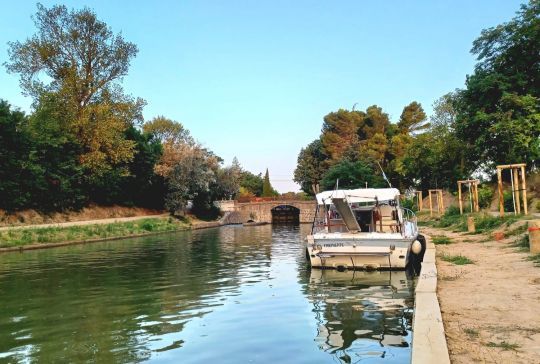
A few hours later, it arrived at its destination in Buzet sur Baïse, where Farniente could be taken out of the water for repairs and restoration over the winter months. This delivery trip gave Stéphane the opportunity to get to grips with the boat, and to identify a number of problems. But despite the pitfalls, in no way will these 16 days of sailing have disgusted him, and our budding sailor can't wait to get his Farniente back into top form and set off on another adventure.

 /
/ 